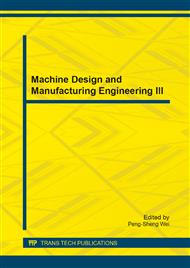p.368
p.376
p.382
p.386
p.393
p.397
p.405
p.409
p.413
CFD Analysis of Energy Loss of Direction Control Valve in Electro-Hydraulic Systems with Inverter
Abstract:
This paper presents a new approach for reducing energy consumption coupled with force and position controls in the electro-hydraulic systems (EHS). The EHS inverter will be added for control to vary the speed of electric motor driven hydraulic pump. In addition, a single directional control valve is used to control the system parameters, which cause loss of energy. The main objective of this research is to numerically analyze the energy loss in the new control approach in the EHS with the inverter by using a simple directional control valve. The spool displacements of 4/3 hydraulic closed center directional control valve, transient flow-pressure coefficient and energy loss were simulated with computational fluid dynamics (CFD). In addition, this paper presents CFD results. The relationships of flow rate variables with time-dependent pressure drop and energy loss were addressed. The flow behaviors related with transient flow-pressure coefficients were also discussed. It is found that the loss of energy increases, depending on both the large opening spool displacement and the inlet flow variable.
Info:
Periodical:
Pages:
393-396
Citation:
Online since:
July 2014
Authors:
Price:
Сopyright:
© 2014 Trans Tech Publications Ltd. All Rights Reserved
Share:
Citation:


